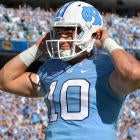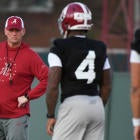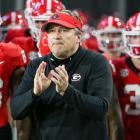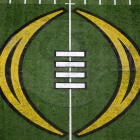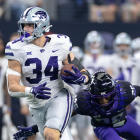I don't know the secret to figuring out whether or not a college quarterback will be good in the NFL. If I did, I wouldn't have written this story because I'd be getting paid millions of dollars by an NFL franchise.
Of course, like NFL general managers and scouts, just because I don't know the secret doesn't mean I haven't spent plenty of time trying to figure it out, and while I'm a long way away from the answer, I have found a way that gives a bit of an edge.
For the last six years, I've been working on a mathematical formula based on a quarterback's statistics and performance in certain situations on the college level. These are situations which I believe give us an idea of how well that player would perform on an NFL level where defenses are smarter, quicker, and just more difficult to defeat.
I haven't published any of the results to this point because I haven't been doing it for work. I've been doing it because I'm a nerd with too much free time on his hands. Also, because I enjoy it. Now, the results have been far from perfect, but I've found that -- miraculously -- the good quarterbacks tend to score higher in my formula than the bad ones do. It's crazy, I know.
For example, the highest score any college quarterback I've done so far was Andrew Luck at Stanford. Luck posted a score of 990.209. This shouldn't come as a surprise, as Luck was a great college quarterback and was then selected with the No. 1 pick of the 2012 NFL Draft by the Indianapolis Colts -- a team that decided it would rather have Luck than some guy named Peyton Manning.
The second-highest score ever posted by a quarterback I've ranked? Well, that would be 986.758. A score that came courtesy of a Texas A&M quarterback named Johnny Manziel. Clearly, that was a bit off, though to be honest, I still maintain that Johnny Manziel's biggest problem in the NFL was Johnny Manziel. Not his ability to actually play quarterback.
Now you're probably wondering how the formula works. While I won't get into the mathematical minutiae, it's really a simple process overall. I simply look at how quarterbacks have performed over their college careers in three key situations: against the top defenses in college football (the top 50 using S&P ratings via Football Outsiders), in third-and-long situations, and in the red zone. The first one is self-explanatory. While college defenses aren't as good as NFL defenses, you can still learn more about a quarterback against the better ones than you will against some team giving up 40 points per game.
As for third-and-long and the red zone, I chose these because they are situations that more closely mimic the kind of defense a QB would see on the NFL level. On third-and-long, a defense knows you're probably passing and is more likely to bring pressure. In the red zone, you have a lot less room to work with, which mimics the smaller windows a QB will have to throw into on the NFL level.
The formula has limitations, however. First of all, I can't include quarterbacks from the FCS level. I get all of the stats I use to put these rankings together from CFBStats.com. It's a great website and wonderful resource, but it only provides statistics for FBS programs and players.
Another limitation is that the formula may not give mobile quarterbacks as much credit as they deserve. All of the statistics I use are judging a quarterback by the passes he's thrown. It's a way to analyze their throws and the decisions they make. Unfortunately, it doesn't include the times a quarterback pulls the ball down and runs -- something which can be extremely valuable and a giant pain in the you-know-what for opposing defenses.
All in all, what I have is something that isn't a complete grade on everything a quarterback has done during his college career but is something that helps give us a better idea of what we can likely expect from him on the next level. It's a starting point more than final evaluation.
As for this year's quarterback class, I ranked the 20 FBS quarterbacks listed on the NFL Draft's website. Everybody from Mitch Trubisky and Deshaun Watson to Cooper Rush and Nick Mullens. The results are probably in line with what you're expecting from the class as a whole.
You've been hearing for months now that this quarterback class is weak, and the numbers in these rankings reflect that stance. Compared to previous classes I've ranked, this was definitely one of the lower-scoring classes. In fact, the only class that scored lower was the one from 2016.
There are also a few scores in here that will surprise you. I know this because they surprised me. Before we get into why, how about we just show you the rankings for the 2017 NFL Draft quarterbacks and then get to analyzing the results?
| Rank | Quarterback | School | Fornelli Rating | 2016 Passing Stats |
|---|---|---|---|---|
1 | Mitch Trubisky | 983.755 | 3,748 yards, 30 TD, 6 INT | |
2 | Pat Mahomes | 960.664 | 5,052 yards, 41 TD, 10 INT | |
3 | Cooper Rush | 951.433 | 3,540 yards, 23 TD, 16 INT | |
4 | 946.237 | 2,855 yards, 27 TD, 7 INT | ||
5 | 938.078 | 2,758 yards, 19 TD, 8 INT | ||
6 | Deshaun Watson | 934.986 | 4,593 yards, 41 TD, 17 INT | |
7 | 928.030 | 2,126 yards, 20 TD, 8 INT | ||
8 | 924.985 | 3,552 yards, 29 TD, 8 INT | ||
9 | 914.523 | 2,366 yards, 11 TD, 6 INT | ||
10 | 909.509 | 4,295 yards, 37 TD, 12 INT | ||
11 | 906.790 | 804 yards, 6 TD, 2 INT | ||
12 | Nick Mullens | 901.312 | 3,272 yards, 24 TD, 11 INT | |
13 | 899.462 | 2,925 yards, 26 TD, 9 INT | ||
14 | Texas A&M | 884.775 | 2,432 yards, 19 TD, 7 INT | |
15 | 879.598 | 2,946 yards, 27 TD, 12 INT | ||
16 | 874.498 | 1,376 yards, 8 TD, 3 INT | ||
17 | 871.778 | 2,169 yards, 8 TD, 12 INT | ||
18 | 868.706 | 1,929 yards, 17 TD, 10 INT | ||
19 | Miami | 866.657 | 3,532 yards, 27 TD, 7 INT | |
20 | 853.481 | 3,533 yards, 33 TD, 4 INT |
Now, right from the start, if I were ranking these quarterbacks based on what I'd seen with my own eyes, I'd have Watson at No. 1, not No. 6. In fact, if I were an NFL general manager, the only quarterback in this entire class I'd even consider in the first round is Watson.
But we all know that's not how it's going to work.
While I was not too surprised to see Trubisky finish No. 1, what did catch me off-guard was the gap in his score compared to everybody else. Furthermore, Trubisky's score is now the third-highest score in the six years I've been doing this. He finishes behind both Luck and Manziel, but ahead of quarterbacks like Jameis Winston (968.207) and Marcus Mariota (962.310). I do have some questions about the results, however.
The biggest is sample size. Trubisky played in a few games as a backup for his first couple of years at North Carolina, but he was only the full-time starter for one season. This limits the number of games he had against the best defenses, though his performance in both third-and-long and red zone situations was incredibly strong. That I cannot deny.
The same can be said of Mahomes, who played a lot more games than Trubisky but did so in the Big 12. He wasn't facing a lot of superior defenses, but he also fared well in third-and-long and red zone situations.
Then there's Watson, who finishes in sixth place. When it comes to performing against the top defenses in the country, Watson provided us the largest sample with which to work. Strictly performing against top defenses, Watson had the highest score of any QB in this class.
Just ask Alabama how he does in such environments.
Where Watson suffered was in third-and-long and red zone situations -- particularly when it came to his completion percentages and interception rate. That dragged his score down below the levels of other first round quarterbacks we've seen like Jared Goff (958.314) and Blake Bortles (949.709). Watson's overall score was close to that of another quarterback who spent a lot of time facing excellent defenses during his years on the college level. Dak Prescott had the second-highest score among QBs in last year's class at 938.488, trailing only Goff. We all saw how Dak did with the Cowboys last season.
Now, I have to point out that while Watson's score was high enough to rank sixth in this class, historically, it's not very good. While there's no set guideline to go by, generally speaking, if a quarterback doesn't score at least a 960.000 in this formula, you should be hesitant using a first round pick on him. As you can see, only two quarterbacks in this class meet that threshold, and Mahomes gets there by the skin of his teeth.
Meanwhile, at the bottom of the list we see a couple of quarterbacks who could go in the first couple of rounds that finished with low scores. Kizer checks in at No. 13 overall with a score of 899.462. Then there's Kaaya at 866.657. To be blunt, that's a horrible score. It's not the worst one I've ever tracked, obviously, but it isn't a score of which to be proud, either. I mean, he scored lower than Leidner, who was the quarterback I expected to have the lowest score before I began the ranking simply because Leidner is a run-first quarterback.
Kaaya is a pro-style quarterback playing in a pro-style offense. Again, none of this means that Kaaya won't possibly go on to have a successful NFL career, but seeing how he scored here, I'd certainly be hesitant about using an early pick on him.












